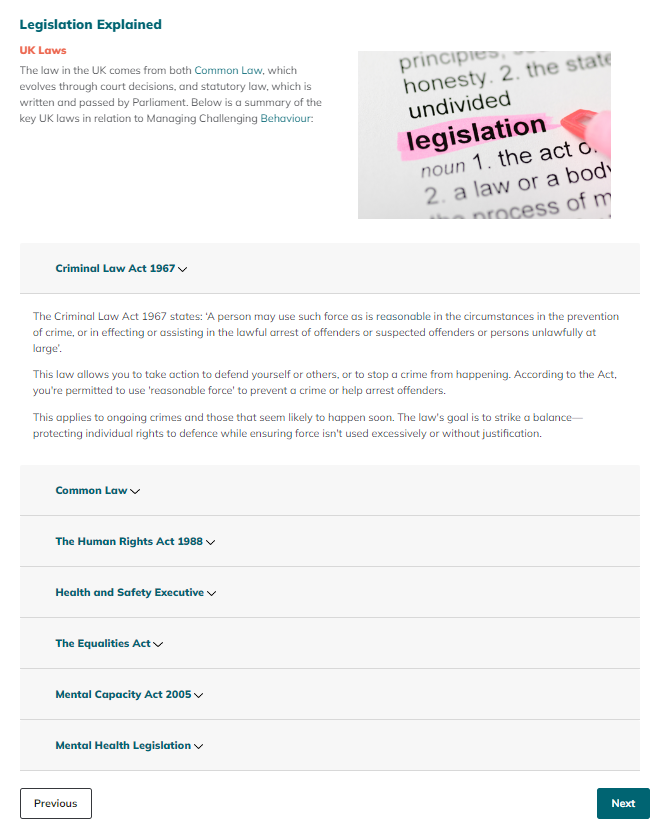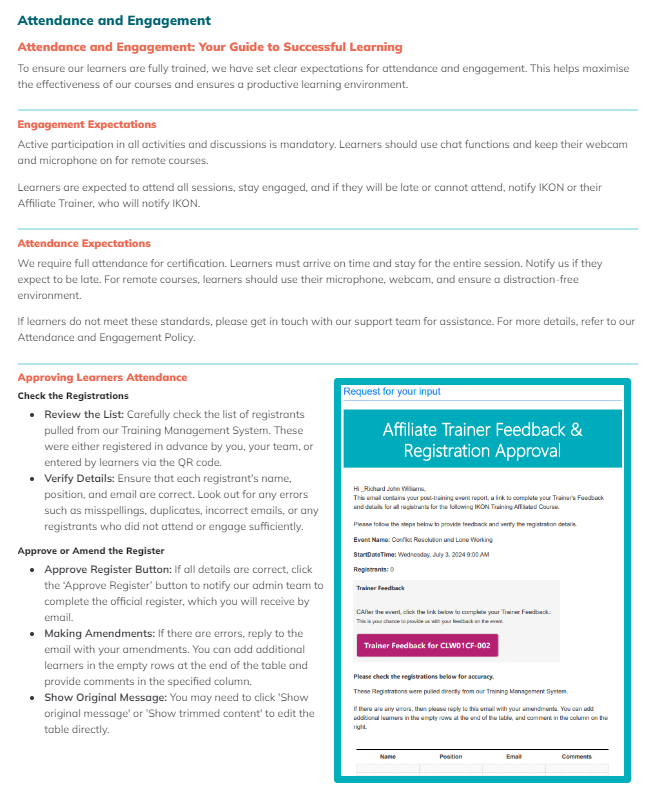The Wider Context
Core Area 3: This section explores how I engaged with legislation, policies, and standards in the context of learning technology.

Evidence of Policy Implementation
Image from the launch of our new Training Management System.
Core Area 3a Legal, Ethical, and Accessibility Issues
This part focuses on demonstrating my understanding of how legal, ethical, and accessibility issues impact my work in learning technology.
Understanding and Engaging with Legislation
In my role as Digital Training and Development Design Lead at IKON Training, understanding and engaging with key legislation such as the GDPR and the Equality Act was central to the successful implementation of the Digital Development Strategy. These legal frameworks shaped how we designed and deployed digital systems, especially in relation to the handling of sensitive learner data and ensuring equal access to our eLearning content. My legal background played a significant role in navigating the complexities of these regulations, allowing me to develop robust solutions that safeguarded both learner rights and organisational integrity.
One of the greatest challenges was ensuring that our approach to digital transformation not only complied with current laws but also anticipated future changes in legislation. I recognised early on that the speed of technological advancement often outpaces legislative updates. Therefore, I incorporated a proactive, forward-thinking strategy, closely monitoring updates to data protection laws and accessibility standards to ensure that our systems remained compliant. This was particularly important as we scaled up our digital infrastructure, integrating new technologies such as automation platforms, Learning Management Systems (LMS), and Customer Relationship Management (CRM) systems.
GDPR and PECR Compliance
As Digital Training and Development Design Lead at IKON Training, ensuring compliance with both the General Data Protection Regulation (GDPR) and the Privacy and Electronic Communications Regulations (PECR) was essential in safeguarding user data and maintaining trust. This multifaceted approach required a comprehensive strategy that covered how learner data was collected, stored, and processed. It also extended to how cookies and tracking technologies were managed on our website, ensuring that all data-handling practices adhered to stringent legal standards. Transparency and user consent were at the core of our compliance efforts.
One of the key challenges was balancing a positive user experience with regulatory obligations. I worked closely with our IT and legal teams to introduce encryption protocols for sensitive data, minimise data retention periods, and conduct regular audits to ensure our processes remained secure. We regularly updated privacy policies to make them accessible and clear for our users, ensuring that consent for data usage was both explicit and informed, in accordance with GDPR. Similarly, PECR regulations, which govern cookies and similar tracking technologies in the UK, required us to implement robust consent mechanisms for non-essential cookies.
A significant part of our compliance efforts was focused on revising how our website handled cookies. Initially, our site did not require a cookie notification due to limited data collection. However, as we integrated tools like HubSpot for lead generation, the situation changed. After a detailed analysis, I concluded that the site needed to comply with PECR and GDPR as the processing of personal data through cookies became more extensive. Working with an external consultancy, I developed a Cookie Management System designed not just to meet minimum compliance requirements but to provide users with full control over their data. The system allowed users to opt in or out of different types of cookies, ensuring transparency and empowering them to manage their data preferences easily.
Competitor Analysis of Legal Compliance
In comparing our GDPR and PECR strategies to those of similar educational institutions, it became clear that IKON Training took a notably proactive approach. While many organisations relied on simple cookie banners to fulfil compliance, we implemented a more comprehensive Cookies Management System that enabled users to dynamically manage their cookie preferences. This not only adhered to legal requirements but also contributed to a more user-friendly experience. During internal audits, this approach was highly praised for giving users control over their data choices, reinforcing the importance of transparency in building user trust.
Our approach went beyond basic compliance and focused on actively educating both learners and staff about their data rights. This level of user engagement was less common among our peers and set IKON apart by fostering a culture of empowerment around data protection. Learners were encouraged to provide feedback on their experience with our data handling practices, and we used this feedback to continuously refine our privacy and cookie policies, ensuring they were both legally compliant and aligned with user expectations.
Explaining Legal Rights and Responsibilities
One of the first resources I developed during the creation of the Moodle IKON Academy was a pre-course resource designed to ensure that learners understood their legal rights and responsibilities in the context of managing challenging behaviour. This resource summarised key UK laws such as the Criminal Law Act 1967, the Equality Act 2010, and the Human Rights Act 1988. These legal frameworks are crucial for our learners, many of whom operate in roles requiring a thorough understanding of legal implications, particularly in relation to the use of force, duty of care, and managing high-stress situations.
The content for this section was developed in close collaboration with the Training Manager, who provided the foundational legal information. I played a key role in translating this information into an accessible, learner-friendly format that avoided unnecessary legal jargon, while still maintaining accuracy and clarity. This process involved breaking down complex legal concepts—such as duty of care, liability, and the use of force—into easily digestible parts that could be readily understood by learners from diverse professional backgrounds. The collaborative effort was essential in ensuring that we conveyed these concepts in a way that was both practical and legally sound, aligning with the course’s overall aim of enhancing professional competence through clarity and precision.
Following the initial development phase, we conducted thorough testing with the live version of the resources to assess how well this legal section met learner needs. The results were overwhelmingly positive, with this section consistently rated as one of the most valuable aspects of the course. Learners appreciated the clear, concise explanation of their legal rights and responsibilities, particularly in relation to their roles in managing challenging or high-stress situations. This feedback reinforced the importance of including such content in our training materials and validated the approach we took in its delivery.
After reflecting on user feedback, we realised that providing this resource before the session posed a risk of misinterpretation, particularly as many of our learners come from diverse backgrounds and have varying levels of proficiency in English. The legislation linked in the document was sometimes complex, and there was concern that learners might arrive at the session with misconceptions or incomplete understandings of the law.
To address this, we made the decision to move this resource to the post-course section, ensuring that the legal concepts were first introduced and explained in context during the training session. This approach allowed the trainer to provide critical framing around the laws and ensure that learners had a firm grasp of their responsibilities before diving deeper into the legal materials. The post-course resource then reinforced the learning, enabling learners to review the legal details on their own, but only after they had received the necessary guidance and context during the live training session.
This decision was supported by the cognitive load theory and the concept of "scaffolding" in learning. By presenting complex legal information in smaller, structured steps, starting with an introduction in the classroom and then reinforcing it online after the session, learners were better able to absorb and process the information. Scaffolding, a pedagogical approach rooted in Vygotsky’s theories of learning, helps learners move from what they currently understand to more complex ideas, with the instructor providing support as necessary. By delaying access to the legal document until after the session, we allowed learners to construct a clearer understanding of legal rights, minimising the risk of cognitive overload.
Additionally, this approach catered to the principles of Universal Design for Learning (UDL) by allowing learners to engage with the legal content in multiple ways. First, through guided instruction with an expert during the training, and later through independent review of the legal resources. This reinforced the learning while ensuring that the material was accessible to learners with different language abilities and learning preferences.
As a result, we found that the revised approach not only reduced the risk of misinterpretation but also increased learner satisfaction with how legal content was introduced. This structured delivery of legal material ensured that learners fully understood their rights and responsibilities, and empowered them to apply this knowledge confidently in their roles, further improving both compliance and learner engagement.
Looking ahead, I plan to continue refining this section based on ongoing feedback and legal developments. As laws evolve, particularly those related to duty of care, physical intervention, and liability, it will be critical to ensure that our content remains current and relevant. I am also exploring the possibility of incorporating interactive legal scenarios into the course, allowing learners to apply their knowledge in simulated environments. This could further enhance their understanding of how legal principles operate in real-world situations and provide them with additional tools to make informed decisions. By staying attuned to both learner needs and legal changes, we can continue to provide valuable, relevant content that supports professional development and legal compliance.
Reflections on Legal Compliance
The process of implementing GDPR and PECR compliance underscored the importance of integrating regulatory requirements with user experience. By working closely with our IT, marketing, and legal teams, we were able to design solutions that met both compliance and organisational goals. One of the key challenges was aligning the needs of the marketing team, who prioritised data tracking and system functionality, with the strict legal requirements of GDPR and PECR, which demanded explicit user consent and high levels of transparency. This project reinforced that compliance is not simply about fulfilling legal obligations but also about fostering trust and transparency through user-centric approaches.
By moving the Legal Rights and Responsibilities resource from Pre-Course access to Post-Course, we were able to support a more robust learning experience that combined the introduction of legal principles during the course with reinforcement through post-course materials. This ensured that the learners could absorb complex legal information more effectively and apply it in their professional settings with greater confidence. The added layer of legal compliance, especially regarding managing challenging behaviours under various UK laws, also highlighted the need for ethical considerations in our design choices, particularly around ensuring learner accessibility and reducing the risk of misconceptions.
Moving forward, my focus will be on continuously refining our data protection processes and legal training content, especially as legislation evolves and new data management technologies emerge. I am also exploring ways to give learners more granular control over their data, as well as more adaptable access to legal information through our learning platform. By staying ahead of regulatory updates and leveraging pedagogical principles, I aim to ensure that IKON remains compliant while enhancing learner trust, comprehension, and engagement with legal content.
Ethical Issues
Health and Safety Awareness
The Digital Development Strategy that I implemented at IKON Training during my first year was not only focused on technological advancements but also on ensuring that all digital transformations aligned with key organisational goals and adhered to legal, ethical, and regulatory standards. A significant part of this strategy involved complying with UK-specific legislation such as the Health and Safety at Work Act 1974, the General Data Protection Regulation (GDPR), and the Equality Act 2010. The strategy followed the ADDIE model (Analysis, Design, Development, Implementation, and Evaluation), ensuring each phase addressed both technological capabilities and compliance with relevant legislation.
During the Analysis and Design phases, it became clear that incorporating automation and compliance mechanisms was critical. The primary objective was to streamline operational processes while upholding the quality of the learner experience, particularly when it came to legal requirements such as health and safety and data protection. The Health and Safety at Work Act 1974 requires employers to ensure the safety of their employees and those affected by their work, including learners. This prompted us to pay close attention to safety measures, especially for courses involving physical activities with inherent risks.
While we were already compliant with health and safety regulations, I wanted to ensure that we went beyond the minimum legal requirements, creating a process that truly prioritised learner well-being and ethical responsibility. This meant empowering learners to make informed decisions about their participation in training, particularly those with personal circumstances that might affect their ability to engage in physical tasks. Ethical training design isn't just about legal compliance—it's about ensuring that learners feel safe, respected, and able to participate fully in their learning experience.
For example, under the old system, health and safety information was only provided at the start of a training session, often requiring learners to disclose personal health information in front of others, which could lead to discomfort. In one case, a woman who had recently discovered she was pregnant contacted us before her session to ask if the training would be suitable for her condition. Under the old system, she would have had to publicly disclose her pregnancy to the trainer on the day, potentially causing embarrassment and anxiety. By providing digital access to health and safety information in advance, she was able to confidentially consult with the Training Manager and ensure the training would be safe for her. This allowed her to participate without stress and receive the training she needed to remain safe in her role. The ethical implications of this case highlight the importance of discretion, privacy, and early engagement to make reasonable adjustments for learners in accordance with the Equality Act 2010.
By embedding this proactive, learner-centric approach into the Development and Implementation phases, we digitalised previously manual processes and automated the delivery of health and safety information. This allowed learners to review safety measures well in advance of sessions, empowering them to make informed decisions about their participation and providing the option to raise concerns discreetly and privately before arriving at the training.
Health and Safety Declaration
A core aspect of this strategy was the digitalisation of the Health and Safety declaration process. Many of our training courses involved physical components, requiring learners to be informed of specific risks and precautions in compliance with the Health and Safety at Work Act 1974. Prior to this digitalisation, this information was only provided at the start of the training session, which sometimes led to rushed and inconsistent communication and failed to meet individual learner needs effectively.
To address these challenges, I designed and implemented a digital version of the Health and Safety declarations. Learners received these via email prior to their session, with a quick and easy-to-access QR code linking to the declaration. This allowed them to review important safety information at their convenience and raise any concerns with the Training Manager before attending. By offering this digital solution, we not only ensured compliance with health and safety regulations but also greatly enhanced the learner experience by providing more control over when and how they engaged with critical information.
The case of the pregnant learner further demonstrated the ethical value of this approach. By allowing her to confidentially access and review health and safety information before the session, she avoided the discomfort of publicly disclosing her pregnancy and was able to discuss her concerns privately with the Training Manager. This empowered her to make an informed decision about her participation, ensuring both her safety and that of her colleagues and customers. This proactive approach aligns with the ethical responsibility to provide a safe and respectful learning environment for all participants, as well as the legal requirement to make reasonable adjustments under the Equality Act 2010.
Reflections on Ethical Considerations
The delivery of health and safety information relied on automation integrated into our Training Management System (TMS). In line with health and safety requirements, the system automatically monitored new registrations for courses flagged as 'Physical' and sent tailored email communications containing a link to the health and safety declaration. A second automation monitored responses and updated the system in real-time to show which learners had accepted the declaration, giving trainers full visibility of participants' health and safety status before the course began.
This digital approach to health and safety compliance not only improved transparency and communication but also allowed both trainers and learners to plan more effectively. Trainers were able to tailor sessions to accommodate learners’ specific needs in accordance with the Health and Safety at Work Act. However, we also learned that learners felt overwhelmed by the volume of pre-course emails, leading us to explore ways to consolidate communications without compromising the clarity or importance of the health and safety information.
Moving forward, I plan to introduce more integrated systems that align automation with user feedback. By refining how information is delivered, we can maintain a learner-centric focus while continuing to meet legal obligations under health and safety laws, GDPR, and the Equality Act. Ethical training design should always balance legal compliance with the experience and well-being of learners, ensuring that safety measures are communicated in ways that are respectful, transparent, and empowering.
Accessibility and Equality
As part of my commitment to upholding the principles of the Equality Act, I spearheaded initiatives to ensure that all of our eLearning content was accessible to a diverse range of learners. This involved not only adhering to legal standards but also embedding accessibility deeply within the design and delivery of our courses. Central to this approach was the application of Universal Design for Learning (UDL) principles, which ensured that our content was flexible, accessible, and adaptable to different learning preferences and needs.
Under the Equality Act, there is a legal requirement to make reasonable adjustments for individuals with disabilities, and in the digital learning space, this translates to ensuring equal access to all online content. I was able to take this requirement further by leveraging UDL principles, which promote a flexible learning environment that can accommodate a variety of learners, including those with visual, auditory, motor, or cognitive impairments. This approach also benefited learners who may not traditionally identify as having disabilities but still faced barriers to learning, such as those for whom English is not a first language.
For a detailed overview of my work on making learning more accessible, please visit the IKON Academy Accessibility page.
Improving Accessibility
The accessibility measures I implemented spanned multiple facets of the eLearning experience. First, we ensured that all video content was accompanied by subtitles and transcripts, which not only catered to learners with hearing impairments but also provided flexibility for those who preferred to consume content in text form. Subtitles also supported learners with different learning styles, making content more digestible and engaging. In addition to this, I introduced the use of colour contrast tools to ensure that all text and visuals adhered to Web Content Accessibility Guidelines (WCAG), thereby making content readable for users with visual impairments or colour blindness.
Beyond video and colour contrast, we also implemented robust keyboard navigation throughout our learning modules. This feature was particularly beneficial for users with motor impairments, allowing them to interact with the content without relying on a mouse. Ensuring that our platform was fully navigable via keyboard meant that learners using assistive technologies like screen readers could engage with the material independently and efficiently. This focus on technical compliance was consistently aligned with WCAG standards, ensuring that we not only met legal requirements but also exceeded them in many areas.
Reflection on Accessibilty
Implementing these accessibility features came with several challenges. One of the primary hurdles was ensuring that accessibility remained a priority during every platform upgrade or modification. While initial compliance is crucial, it is equally important to maintain that standard as technology evolves. Each time we updated the platform, it required careful scrutiny to ensure that no accessibility features were inadvertently compromised. For example, during a system upgrade, we discovered that some newly introduced visual elements did not meet WCAG colour contrast ratios, necessitating immediate adjustments.
One of the most valuable insights I gained from this process was the importance of involving real users with disabilities in the testing phase. While automated accessibility testing tools like WAVE and AXE can identify many issues, they often miss usability challenges that affect actual users. By conducting user testing with individuals who have disabilities, notably a colleague's friend with a visual impairment, we were able to gather authentic feedback and make meaningful improvements. This approach not only helped us catch issues that might otherwise have gone unnoticed but also allowed us to design a more inclusive learning experience.
Another challenge was ensuring that all stakeholders, including developers and content creators, fully understood the importance of accessibility from the outset. This required ongoing training and the development of clear guidelines, which I led as part of a broader accessibility strategy. I also initiated accessibility audits at regular intervals, which allowed us to continually assess our platform’s performance against current standards and make improvements where necessary. For these audits, I used a range of tools such as the Developer's Lighthouse Accessibiliy auditor, as well as Moodle's inbuilt accessibility checker. As a result, we were able to establish a strong foundation of accessibility that not only complied with legislation but also enhanced the overall learner experience.
Next Steps
In the future, I plan to further expand our use of assistive technology, exploring options like voice-activated controls and AI-driven captioning services. By staying informed about emerging accessibility technologies, we can continue to provide an inclusive learning environment that meets the needs of all users, regardless of their abilities or learning preferences.
Core Area 3b Policies and Standards
This section focuses on my understanding of how learning technology fits within broader institutional, sector-wide, and professional policies and standards.
Internal Policy Development
Developing Internal Policy
One of the key policies I developed during my time as the Digital Training and Development Design Lead at IKON Training was the Attendance and Engagement Policy. This policy was essential in setting clear expectations for learner attendance, participation, and engagement throughout our courses. Recognising the need for a structured approach to ensure that both clients and learners were fully aware of their responsibilities, I took a proactive role in developing a policy that aligned with the institution's broader goals, sector-wide best practices, and professional standards for engagement and accountability.
I found that, in the mandatory training sector, attendance and engagement policies varied greatly, as did the law around enforcing attendance and tracking engagement. Different sectors had varying legal obligations, particularly when it came to professional accreditation and regulatory compliance. For example, healthcare and education sectors required stricter attendance tracking due to their respective regulations, such as the Health and Social Care Act and the Education Act. These sectors needed robust mechanisms to ensure learners met their mandatory training requirements, whereas in other industries, the enforcement of such policies was more flexible and left to individual organisations. Recognising this, I ensured that our Attendance and Engagement Policy was not only compliant with relevant legal frameworks but also adaptable to the needs of different sectors, allowing us to meet both regulatory requirements and institutional goals.
In the initial stages, the focus was on ensuring that the policy addressed common challenges, such as maintaining high levels of learner engagement, preventing dropout rates, and establishing consequences for non-attendance or lack of participation. The policy aimed to balance learner flexibility with institutional expectations, ensuring that all learners received a consistent and fair learning experience.
Reviewing and Revising the Policy
As part of our commitment to continuous improvement, we conducted a thorough review of the Attendance and Engagement Policy after its initial implementation. Feedback was collected from learners, trainers, and other stakeholders, such as key clients, to assess our policy's relevance and effectiveness.
The review process allowed us to identify areas that required further clarification or adaptation to better meet the needs of our clients and learners. For example, we noticed that the original policy did not fully account for learners with accessibility needs or differing learning environments, so revisions were made to ensure that the policy remained inclusive and flexible.
I worked closely with both internal teams and external stakeholders to revise the policy, ensuring it remained aligned with professional standards and institutional values while remaining adaptable to the varying needs of different learning cohorts.
Ensuring Client and Learner Awareness
Ensuring that both clients and learners were aware of and understood the Attendance and Engagement Policy was a crucial part of the rollout. To achieve this, we implemented multiple communication channels for policy dissemination.
- Pre-Course Communication: The policy was hyperlinked in all pre-course materials provided to learners through the TMS pre-course emails. Learners were required to review and acknowledge the policy before enrolling in the course, ensuring that they were fully informed of their responsibilities before the course began.
- Client Communication: Our clients, who often commissioned training on behalf of their employees, were also informed about the policy to ensure consistency in expectations. Regular updates and briefings were provided to our key clients to ensure they understood how the policy would affect their learners' participation and success in the course.
This process not only helped ensure compliance but also fostered a transparent relationship between our organisation, the learners, and the clients. To ensure awareness, the process the Attendance and Engagement policy was also embedded in the Registration Form, used for the registration of learners. So anyone self-registering would have to select that they were aware of this, and anyone registered by someone within their organisation would receive a copy of the attendance and engagement policy within their course welcome email.
Enforcing the Policy with Affiliate Trainers
One of the most significant challenges we faced was ensuring that our affiliate trainers, who were delivering our training on-site for their own learners, were fully aware of and applying the Attendance and Engagement Policy. Previously, we had no formal mechanism for tracking whether trainers were enforcing this policy during their sessions, which created inconsistencies in its application.
To address this, we took several key steps:
- Affiliate Trainer Briefing: I conducted detailed briefings with our new affiliate trainers to ensure they understood the importance of enforcing the policy during their sessions. This was delivered through live training sessions, as well as follow-up resources, including guides and FAQs, available on our online platform.
- Policy Integration into Trainer Materials: The policy was integrated into all training resources provided to the affiliate trainers. This included session plans, learner tracking systems, and post-session reports. By using our TMS fo the registation and attendance of their learners, Trainers were required to document learner attendance and engagement levels, allowing us to monitor compliance more effectively.
- Monitoring and Feedback: A system was implemented to monitor affiliate trainer compliance. Feedback from trainers and learners was regularly collected, and affiliate trainers were encouraged to provide updates on any issues they faced in enforcing the policy through their Trainer's Synopsis, which was intergrated into the Affiliate Trainer process to ensure improve visibiliyt and to give the Affiliate a chance to feedback on their experience. This allowed us to provide additional support where needed and ensure the policy was consistently applied across all training sessions.
Reflection
The development, revision, and enforcement of the Attendance and Engagement Policy highlighted the importance of aligning internal policies with broader institutional and sector-wide standards. By developing a clear, consistent policy and ensuring its enforcement across all levels—learners, clients, and affiliate trainers—we were able to foster greater accountability and improve the overall quality of our training programs.
In addition, this process emphasized the need for ongoing review and adaptation of policies to remain relevant and effective. The integration of monitoring mechanisms for affiliate trainers ensured that our policies were not only created but also actively enforced, thereby aligning with both institutional values and sector-wide professional standards.
Client Policy - External Policy Engagement
Engaging with institutional policies, beyond legal frameworks like GDPR and the Equality Act, was essential in shaping the digital landscape at IKON Training. These policies provided the foundation for ensuring that eLearning initiatives not only met regulatory standards but also aligned with the ethical, pedagogical, and quality standards of the organisation. My role involved actively contributing to the development and refinement of policies related to eLearning, with a particular focus on quality assurance, ethical data use, and the responsible integration of technology into the learning environment.
NHS Policy Compliance Coordination
One of IKON's key sectors is the NHS, and their policies related to data protection, accessibility, and training delivery have a significant impact on how we design and deploy our learning technology solutions. The NHS operates under some of the strictest data security and compliance standards, such as GDPR and the Health and Social Care Act, which necessitated a close alignment of our internal processes with NHS policy requirements. This external policy engagement was vital in ensuring that our training solutions could be integrated seamlessly into NHS frameworks, thus fostering trust and enhancing our collaborations with various NHS Trusts. As we engaged with these clients, it became clear that our policies around data protection, accessibility, and training needed to be continuously reviewed and adapted to stay in line with evolving NHS standards and best practices.
One of the most significant projects I led was coordinating policy alignment with a large NHS Trust as part of the rollout of our Affiliate Trainer Program. In this program, NHS trainers delivered our training content to their own learners. This involved not only the transfer of training materials but also the collection and management of learner data, which required strict adherence to both our own data protection policies and the NHS Trust’s policies and guidelines, especially given the sensitive nature of their work.
To initiate the program, I visited the NHS Trust on-site and conducted several follow-up meetings, via Teams. The key objective was to ensure that our policies aligned with their internal regulations, particularly around GDPR and data sharing. As we were holding data on NHS learners, we had to ensure that our processes conformed to the Trust’s data protection requirements, in addition to adhering to the Data Protection Act and GDPR.
In response to this work, I assisted with the redrafting of IKON’s Privacy and Personal Data policy, which governs how learner information is collected, used, and protected. This policy needed to reflect not only the legal requirements of GDPR but also the ethical standards of transparency and respect for learner autonomy. In revising the policy, I introduced clearer language to make it more accessible to learners, avoiding complex legal jargon that could create confusion. A major focus was on simplifying the consent process to ensure that learners were fully informed about how their data would be handled without feeling overwhelmed by the information provided.
Reflection: This project underscored the importance of policy engagement and coordination when working with large, highly regulated organisations such as the NHS. Ensuring legal compliance while maintaining operational efficiency required a deep understanding of both internal and external regulations. Aligning our policies with those of the NHS Trust not only safeguarded us legally but also enhanced the trust and collaboration between our organisations. The NHS has some of the most stringent data-security regulations, yet their processes are often quite manual, and occasionally antiquated. By working to their requirements, we have developed processes and policies that meet the needs or a very broad range of clients with less strict polices, and more streamlined processes.
Live Captioning Policy
During my time at the University, a key focus of my work was ensuring that our lecture and learning content met legal requirements related to accessibility, particularly live captioning. The Public Sector Bodies (Websites and Mobile Applications) Accessibility Regulations 2018 provided a clear mandate for ensuring that time-based media, such as videos, included captions and transcripts for pre-recorded content. However, live content, while not explicitly required to be captioned under the law, was subject to guidelines recommending that any live content archived for more than 14 days be treated as pre-recorded and made accessible accordingly. This presented both an opportunity and a challenge for us in balancing compliance with the practicalities of delivering real-time content.
The need to ensure accessibility for all learners, particularly those with hearing impairments, drove my decision to initiate a comprehensive review of our live captioning practices. Recognising that this was an area where technology could play a transformative role, I explored various tools, including automatic speech recognition (ASR) technologies, to provide live captions during lectures and convert those captions into accessible formats for archived content. This not only helped us comply with current guidelines but also future-proofed our practices against potential legislative changes that could mandate live captioning for all public sector institutions.
In leading this initiative, I compared our live captioning strategies with those of other leading institutions to identify best practices and technological innovations. This benchmarking process was crucial, as it allowed us to learn from the successes and challenges faced by others in the sector. We examined a range of ASR tools and captioning technologies for their accuracy, ease of integration with our existing systems, and user-friendliness. One of the critical considerations was ensuring that the technology could not only handle the real-time demands of live captioning but also provide high-quality, accurate transcripts for later use. This was particularly important in maintaining both legal compliance and the pedagogical integrity of our materials.
Implementing live captioning solutions was not without its challenges. Balancing legal compliance with practical feasibility was a constant focus. Although we aimed to provide high-quality captions in real-time, the limitations of existing technologies often meant that some manual editing of captions was required after the fact. This added complexity to the process, but it was necessary to ensure that the final captions met the necessary accuracy standards and provided real value to the learners who depended on them.
My work on live captioning compliance was a reflection of my broader commitment to creating an inclusive and accessible learning environment. I recognised early on that while legal compliance was a key driver, it was just as important to ensure that the solutions we implemented truly enhanced the learning experience for all students. This meant advocating for the best practices in digital accessibility, not just meeting the minimum requirements. By focusing on the learner experience, I was able to ensure that our approach to captioning was both legally sound and pedagogically beneficial.
Looking forward, I plan to continue refining our live captioning practices by staying informed about advancements in captioning technologies and accessibility regulations. As AI-driven ASR technologies improve, I believe there will be significant opportunities to enhance the accuracy and efficiency of real-time captions. Additionally, I am exploring ways to integrate more interactive elements into our captioning system, such as enabling learners to highlight sections of captions or transcripts for further clarification or context. By remaining adaptive and forward-thinking, I aim to ensure that our live captioning solutions evolve in line with both legal standards and the needs of our learners.
Reflections on Engaging with Policy
Reflecting on my experience developing and revising internal policies like the Attendance and Engagement Policy and engaging with external policies such as those of the NHS, I have gained a deeper appreciation for the complexity of aligning institutional practices with broader legal, ethical, and sector-wide standards. These processes have highlighted the need for not only strict adherence to legal requirements but also the necessity of embedding flexibility to meet the diverse needs of clients, learners, and affiliate trainers.
The iterative development of the Attendance and Engagement Policy revealed the importance of ensuring that policies are continuously reviewed, not just for legal compliance but also for accessibility and effectiveness. For example, revising the policy to accommodate learners with diverse needs, and ensuring that affiliate trainers consistently applied the policy across sessions, underscored the importance of creating adaptable, inclusive solutions. This process taught me that legal frameworks like GDPR, the Health and Social Care Act, and the Equality Act provide a necessary foundation, but successful policy engagement requires flexibility and ongoing dialogue with stakeholders to ensure the policy is fully understood and properly enforced.
My work with NHS learning and development teams, in particular, demonstrated how external partnerships demand a heightened level of compliance coordination. The NHS Trusts we worked with required stringent adherence to data protection, accessibility, and training delivery standards. Aligning our internal processes with these external frameworks reinforced the need for precise and transparent policies. The ongoing communication and coordination ensured that our systems not only remained compliant but also reflected the NHS's high standards for data security and learner care.
I have learned that effective policy engagement is not merely about drafting compliant documents but about ensuring that those policies are actionable, clear, and aligned with broader institutional goals, and that they are ultimately enforced. Whether developing internal attendance policies or aligning our processes with NHS standards, the key is to create policies that are not just rules to follow but frameworks that improve outcomes for both the organisation and learners.
Next Steps
Moving forward, my focus will continue to be on the intersection of policy, technology, and learning. I am committed to refining internal policies to ensure they remain relevant as technology evolves, particularly in areas such as accessibility, data protection, and learner engagement. I will also continue working closely with external stakeholders, like the NHS, to ensure our learning solutions meet the highest standards of compliance and effectiveness.
Additionally, I plan to explore the integration of AI-driven tools to automate policy enforcement and improve real-time compliance checks. These advancements could allow us to maintain an adaptable, learner-centric approach while ensuring that we meet our legal and ethical obligations across all platforms.
Engaging with policies—whether internal or external—requires balancing regulatory compliance with ethical considerations. My aim is to continue fostering a culture of transparency, inclusivity, and accountability in the field of learning technology. By doing so, I can help ensure that the solutions we provide not only meet legal standards but also support learners in meaningful, responsible ways.
If you would like to discuss policy engagement or explore potential collaborations, please feel free to contact me via the links below.
To explore my experiences and strategies in collaborating and communicating effectively in the context of our eLearning initiatives, please visit the Next Page - Communication.







